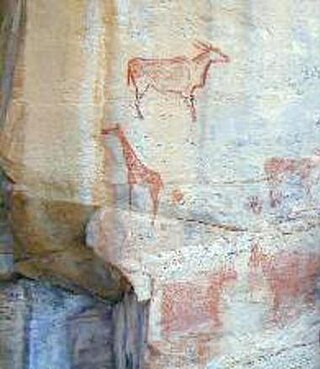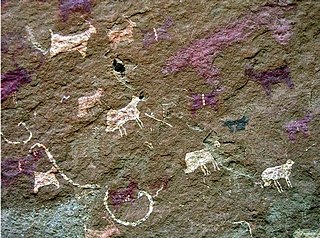
Lascaux is a network of caves near the village of Montignac, in the department of Dordogne in southwestern France. Over 600 parietal wall paintings cover the interior walls and ceilings of the cave. The paintings represent primarily large animals, typical local contemporary fauna that correspond with the fossil record of the Upper Paleolithic in the area. They are the combined effort of many generations. With continued debate, the age of the paintings is now usually estimated at around 17,000 - 22,000 years. Because of the outstanding prehistoric art in the cave, Lascaux was inducted into the UNESCO World Heritage List in 1979, as an element of the Prehistoric Sites and Decorated Caves of the Vézère Valley.

In archaeology, cave paintings are a type of parietal art, found on the wall or ceilings of caves. The term usually implies prehistoric origin. These paintings were often created by Homo sapiens, but also Denisovans and Neanderthals; other species in the same Homo genus. Discussion around prehistoric art is important in understanding the history of the Homo sapiens species and how Homo sapiens have come to have unique abstract thoughts. Some point to these prehistoric paintings as possible examples of creativity, spirituality, and sentimental thinking in prehistoric humans.

In the history of art, prehistoric art is all art produced in preliterate, prehistorical cultures beginning somewhere in very late geological history, and generally continuing until that culture either develops writing or other methods of record-keeping, or makes significant contact with another culture that has, and that makes some record of major historical events. At this point ancient art begins, for the older literate cultures. The end-date for what is covered by the term thus varies greatly between different parts of the world.

The Bhimbetka rock shelters are an archaeological site in central India that spans the Paleolithic and Mesolithic periods, as well as the historic period. It exhibits the earliest traces of human life in India and evidence of the Stone Age starting at the site in Acheulian times. It is located in the Raisen District in the Indian state of Madhya Pradesh, about 45 kilometres (28 mi) south-east of Bhopal. It is a UNESCO World Heritage Site that consists of seven hills and over 750 rock shelters distributed over 10 km (6.2 mi). At least some of the shelters were inhabited more than 100,000 years ago.

In archaeology, rock arts are human-made markings placed on natural surfaces, typically vertical stone surfaces. A high proportion of surviving historic and prehistoric rock art is found in caves or partly enclosed rock shelters; this type also may be called cave art or parietal art. A global phenomenon, rock art is found in many culturally diverse regions of the world. It has been produced in many contexts throughout human history. In terms of technique, the four main groups are:

The Tsodilo Hills are a UNESCO World Heritage Site (WHS), consisting of rock art, rock shelters, depressions, and caves in Botswana, Southern Africa. It gained its WHS listing in 2001 because of its unique religious and spiritual significance to local peoples, as well as its unique record of human settlement over many millennia. UNESCO estimates there are over 4500 rock paintings at the site. The site consists of a few main hills known as the Child Hill, Female Hill, and Male Hill.

Font-de-Gaume is a cave near Les Eyzies-de-Tayac-Sireuil in the Dordogne department of south-west France. The cave contains prehistoric polychrome cave paintings and engravings dating to the Magdalenian period. Discovered in 1901, more than 200 images have been identified in Font-de-Gaume. Along with other nearby prehistoric archeological sites, Font-de-Gaume was inscribed on the UNESCO World Heritage List in 1979 as the Prehistoric Sites and Decorated Caves of the Vézère Valley.
Barechhina is an Indian village in Almora district, Uttarakhand, 18 km from the district headquarters, the city of Almora. . It lies on highway from Almora-Barechhina-Dhaulchina-Sheraghat-RaiAgar-Berinag-Chaukori-Thal-Tejam to Munsiyari.

Chumash rock art is a genre of paintings on caves, mountains, cliffs, or other living rock surfaces, created by the Chumash people of Southern California. Pictographs and petroglyphs are common through interior California, the rock painting tradition thrived until the 19th century. Chumash rock art is considered to be some of the most elaborate and plentiful rock art tradition in the region.

The group of over 700 sites of prehistoric Rock art of the Iberian Mediterranean Basin, also known as Levantine art, were collectively declared a World Heritage Site by UNESCO in 1998. The sites are in the eastern part of Spain and contain rock art dating to the Upper Paleolithic or Mesolithic periods of the Stone Age. The art consists of small painted figures of humans and animals, which are the most advanced and widespread surviving from this period, certainly in Europe, and arguably in the world, at least in the earlier works. It is notable for the number of places included, the largest concentration of such art in Europe. Its name refers to the Mediterranean Basin; however, while some sites are located near the sea, many of them are inland in Aragon and Castilla–La Mancha; it is also often referred to as Levantine Art.

The art of the Upper Paleolithic represents the oldest form of prehistoric art. Figurative art is present in Europe and Southeast Asia, beginning around 50,000 years ago. Non-figurative cave paintings, consisting of hand stencils and simple geometric shapes, are somewhat older, at least 40,000 years old, and possibly as old as 64,000 years. This latter estimate is due to a controversial 2018 study based on uranium-thorium dating, which would imply Neanderthal authorship and qualify as art of the Middle Paleolithic.

The history of cave paintings in India or rock art range from drawings and paintings from prehistoric times, beginning in the caves of Central India, typified by those at the Bhimbetka rock shelters from around 10,000 BP, to elaborate frescoes at sites such as the rock-cut artificial caves at Ajanta and Ellora, extending as late as 6th–10th century CE.

The Cantabrian caves' unique location make them an ideal place to observe the settlements of early humans thousands of years ago. The magnificent art in the caves includes figures of various animals of the time such as bison, horses, goats, deer, cattle, hands and other paintings. Archaeologists have found remains of animals such as bears, the remains of arrows and other material indicating a human presence; these artifacts are now found mostly in the Regional Museum of Prehistory and Archaeology of Cantabria.

The Roca dels Moros or Caves of El Cogul is a rock shelter containing paintings of prehistoric Levantine rock art and Iberian schematic art. The site is in El Cogul, in the autonomous community of Catalonia, Spain. Since 1998 the paintings have been protected as part of the Rock art of the Iberian Mediterranean Basin, a UNESCO World Heritage Site. Inscriptions in Northeastern Iberian script and in Latin alphabet indicate that the place was used as a sanctuary into Iberian and Roman times.

Rock art has been produced in Europe since the Upper Palaeolithic period through to recent centuries. It is found in all of the major regions of the continent. One of the most famous examples of parietal art is the Grotte Chauvet in France. The cultural purpose of these remnants of the Paleolithic and other periods of prehistoric art is not known. However, some theories suggest that, because these paintings were created in parts of the caves that were not easily accessed, it is unlikely that they were intended simply as decoration.

Dhambalin is an archaeological site in the central Sahil province of Somaliland. The sandstone rock shelter contains rock art depicting various animals such as horned cattle and goats, as well as giraffes, an animal no longer found in the country. The site also features the earliest known pictures of sheep in Somaliland. Discovered in autumn 2007, residents of Beenyo Dhaadheer reported the rock art to the Somali archaeologist Sada Mire, Director of the Department of Archaeology within the Ministry of Tourism and Culture of Somaliland.
Yashodhar Mathpal is an Indian archaeologist, painter, curator, Gandhian and Rock art conservationist. He is most known for his study of cave art, especially in Bhimbetka rock shelters, Barechhina (Uttarakhand) and Kerala. He founded the Folk Culture Museum in Bhimtal, Nainital district, in 1983.

The Ambadevi rock shelters are part of an extensive cave site, where the oldest yet known traces of human life in the central province of the Indian subcontinent were discovered. The site is located in the Satpura Range of the Gawilgarh Hills in Betul District of the Indian state of Madhya Pradesh, north of Dharul village in Amravati district of Maharashtra. Studies of various rock paintings and petroglyphs present in the caves suggest, that the Ambadevi rock shelters were inhabited by prehistoric human settlers since around 25,000 years ago. First discoveries of clusters of numerous rock shelters and caves were made by Vijay Ingole and his team beginning on 27 January 2007. Named after the nearby ancient Ambadevi Cave Temple, the site has also been referred to as the Satpura-Tapti valley caves and the Gavilgarh-Betul rock shelters. The Ambadevi rock shelters rank among the most important archaeological discoveries of the early 21st Century in India, on par with the 20th Century discovery of the Bhimbetka rock shelters.

Lubang Jeriji Saleh is a limestone cave complex in Indonesia in the Sangkulirang-Mangkalihat Karst, located in the remote jungle of Bengalon district in East Kutai, East Kalimantan province on Borneo island. In a 2018 publication, a team of researchers announced to have found the then-oldest known work of figurative art on the world among the cave paintings, at 40,000 years old. However, the same team has since found and dated an elaborate therianthrope rock art panel in the Leang Bulu' Sipong 4 cave in Sulawesi's Maros-Pangkep karst to around 44,000 years ago.




















